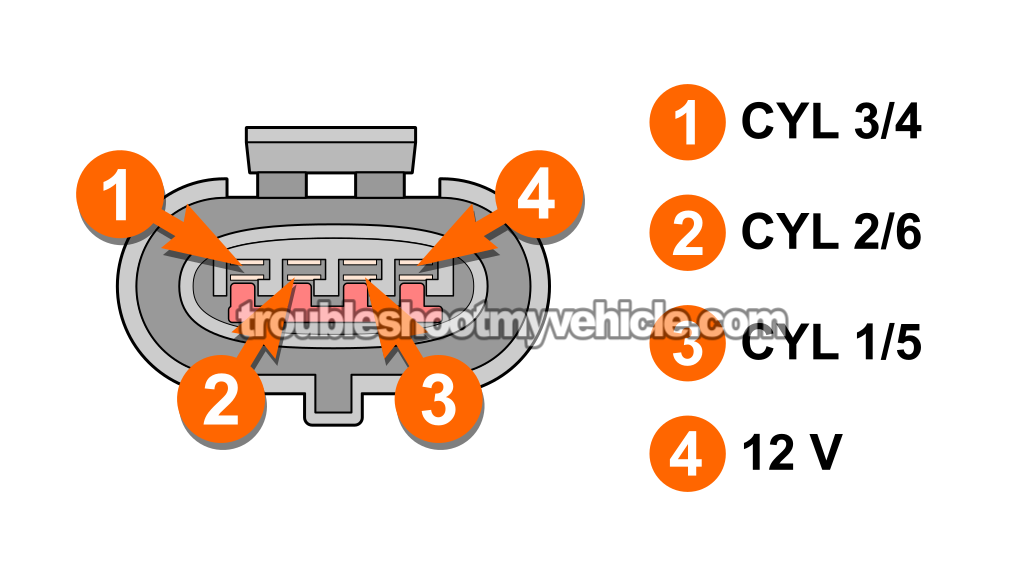TEST 8: Checking The IC Activation Signals

Your coil pack tests have confirmed the following:
- None of the six spark plug wires are producing spark (TEST 1).
- The WHT/BLU wire is delivering 10 to 12 Volts to the coil pack (TEST 4).
For our final check, we're going to verify that the activation signals for ignition coils 1, 2, and 3 are reaching the coil pack. We'll do this using a regular 12-Volt automotive test light (non-powered type that uses an incandescent light bulb).
Here's the connector pinout for the ignition coil pack:
- Terminal 1: Yellow with red stripe (YEL/RED) wire – activation signal for cylinders 3 and 4.
- Terminal 2: Yellow with white stripe (YEL/WHT) wire – activation signal for cylinders 2 and 6.
- Terminal 3: Yellow with black stripe (YEL/BLK) wire – activation signal for cylinders 1 and 5.
IMPORTANT: Gently probe the female terminals with your test light. If the terminal or connector gets damaged, the entire connector will have to be replaced.
CAUTION: This test must be done while cranking the engine. Stay alert and follow all necessary safety precautions!
NOTE: If you don't own a regular incandescent type 12-Volt test light, this is the one that I use and recommend: Lisle 28400 Heavy Duty 12 Volt Test Light (Amazon affiliate link).
Alright, let's start:
- 1
Disconnect the coil pack from its 4-wire electrical connector.
- 2
Connect the 12V test light's alligator clip to the battery positive (+) post.
- 3
With the test light's probing tip, gently probe terminal number 1.
- 4
Have your helper crank the engine.
- 5
The 12V test light should flash ON and OFF the whole time the engine is cranking.
- 6
Repeat steps 2 thru 5 on female terminals 2 and 3.
Let's find out what your test result means:
CASE 1: The 12V test light flashed ON and OFF the entire time the engine was cranking at each terminal. Seeing the test light pulse at all three terminals tells us the PCM is sending out all of the activation signals for the three ignition coils inside the coil pack.
You can call the ignition coil pack bad only if you've already confirmed the following:
- All six spark plug wires aren't firing spark (TEST 1).
- The coil pack is getting power (TEST 4).
- All three ignition coil activation signals are present at the connector (this test section).
When you're ready to replace the cold pack, these are the ones I recommend:
- Standard Motor Products FD488T Ignition Coil Pack (Amazon affiliate link).
- Delphi GN10180 Ignition Coil Pack (Amazon affiliate link).
CASE 2: The 12V test light did NOT flash ON and OFF at any terminal while cranking the engine. When none of the terminals show a flashing signal, it usually points to a crankshaft position (CKP) sensor issue.
Your next step is to test the CKP sensor:
Other Things That Can Cause A Misfire

One of the things that can really throw a wrench into the diagnostic process is that a bunch of other issues —besides a bad ignition coil pack— can also cause an engine to misfire.
So if your tests have proven that the ignition coil pack is doing its job (meaning it's producing and delivering spark to all six cylinders), the suggestions in this section might point you toward a few other areas to check. These extra steps should help you zero in on what's actually causing the misfire.
- Check for carbon tracks:
- Carbon tracks usually form on the spark plug's porcelain insulator or inside the spark plug boot. They're most commonly caused by engine oil seeping out of the valve covers.
- Take a close look at the inside of each spark plug wire boot and the ceramic insulator on the spark plug itself. If you spot carbon tracks on either one, replace the affected parts.
- The orange arrows in the photo above show you exactly what a carbon track looks like.
- Here's a case study that walks you through a real-world carbon track issue: Carbon Tracks Are A Common Cause Of Ignition Misfires (at: easyautodiagnostics.com).
- Check for damaged spark plug wires:
- One of the most common problems is a torn or cracked spark plug boot. The boot's job is to cover the wire's metal terminal, and when it's damaged, that terminal gets exposed. Once exposed, the spark can jump to the exhaust manifold instead of the spark plug.
- Another issue I've run into many times is a spark plug wire missing its metal terminal entirely. And let me tell you, this is a very, very common issue on the 3.0L V6 engine. It happens when the spark plug wire was pulled off the spark plug by hand instead of using spark plug wire pullers.
- Replace any spark plug wire that has a damaged boot or is missing its metal terminal.
- Look for burned or cut spark plug wires:
- When spark plug wires aren't routed the way they should be, they can end up resting against the exhaust manifold or a sharp edge on the engine. That heat or friction can burn through or slice the wire. Once the insulation is damaged, the spark jumps to Ground at that spot instead of reaching the spark plug, and that's an instant misfire.
- Replace any spark plug wire that shows signs of burning or physical damage.
- Check for low cylinder compression:
- The compression test is one of the most overlooked steps when tracking down the real cause of a misfire.
- You'll need a basic engine compression tester to perform this check.
- The compression readings between cylinders shouldn't differ by more than about 15%.
- How To Do And Interpret An Engine Compression Test (1990-2007 3.0L V6 Ford Taurus, Mercury Sable).
- Check for a bad or clogged fuel injector:
- There are quite a few different ways to test the fuel injectors. And the one I've used with a lot of success is measuring the internal resistance of the fuel injector with a multimeter in Ohms mode. What I'm looking for here is a fuel injector that shows an open-circuit —internally, of course. Usually, you'll get a reading in the infinite Ohms range or the multimeter will spit out the letters OL, indicating an open-circuit.
- In certain cases, even if the internal resistance of the fuel injector doesn't show an open-circuit, it might show a radically different resistance value compared to the rest. And that injector, more than likely, has an internal problem.
- The other method I've had a lot of success with —especially when I suspect the fuel injector is clogged but its internal resistance is OK— is to remove the injector and attach it to a DIY fuel injector cleaner tool. The fuel injector is connected to a can of brake cleaner via a handheld adapter, and there's a power module used to activate the injector so you can physically see the spray pattern. This tool, for me, has been a game changer when diagnosing a clogged fuel injector causing a cylinder misfire.
More 3.0L V6 Ford Taurus And Mercury Sable Diagnostic Tutorials
If this tutorial was helpful, be sure and take a look at all of the 3.0L V6 Ford Taurus and Mercury Sable diagnostic tutorials and wiring diagrams in this index:
Here's a sample of the tutorials you'll find there:
- How To Test The MAF Sensor (1996-1999 3.0L V6 Ford Taurus, Mercury Sable).
- How To Test The TPS With A Multimeter (1996-2007 3.0L V6 Ford Taurus, Mercury Sable).
- How To Test For A Blown Head Gasket (1990-2007 3.0L V6 Ford Taurus, Mercury Sable).
- How To Do And Interpret An Engine Compression Test (1990-2007 3.0L V6 Ford Taurus, Mercury Sable).

If this info saved the day, buy me a beer!

